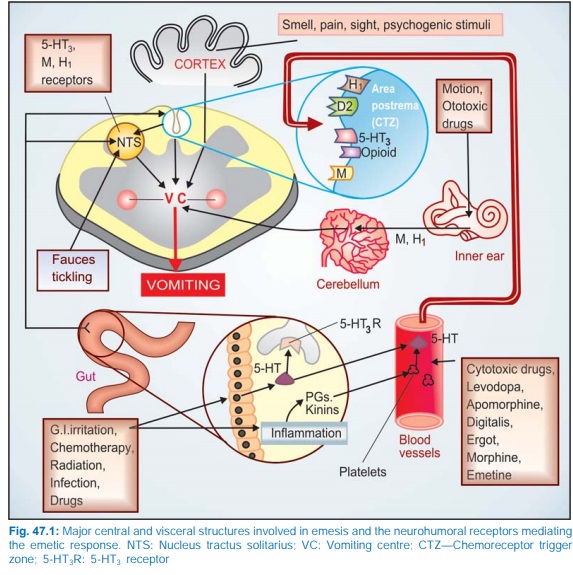Emesis
| Home | | Pharmacology |Chapter: Essential pharmacology : Drugs For Emesis, Reflux And Digestive Disorders
Vomiting occurs due to stimulation of the emetic (vomiting) centre situated in the medulla oblongata. Multiple pathways can elicit vomiting.
EMESIS
Vomiting occurs due to
stimulation of the emetic (vomiting) centre situated in the
medulla oblongata. Multiple pathways can elicit vomiting (Fig. 47.1). The chemoreceptor trigger zone (CTZ) located
in the area postrema and the nucleus tractus solitarius (NTS) are the most
important relay areas for afferent
impulses arising in the g.i.t, throat and other viscera. The CTZ is also
accessible to bloodborne drugs, mediators, hormones, toxins, etc. because it is
unprotected by the blood-brain barrier. Cytotoxic drugs, radiation and other
g.i. irritants release 5HT from enterochromaffin cells → acts on 5HT3
receptors present on extrinsic primary afferent neurones (PAN) of the enteric
nervous system (ENS), which connect with vagal and spinal visceral afferents to
send impulses to NTS and CTZ. Released in large quantity, 5HT may also spill
into circulation and reach CTZ. It may as well be released from platelets by
inflammatory mediators. However, 5HT is not the only mediator of such signals:
many peptides and other messengers are also involved.

The CTZ and NTS express a variety of receptors, e.g. histamine H1,
dopamine D2, serotonin 5HT3, cholinergic M and opioid μ through which the
emetic signals are relayed and which could be targets of antiemetic drug
action.
The vestibular
apparatus generates impulses when body is rotated or equilibrium is disturbed or
when ototoxic drugs act. These impulses reach the vomiting centre mainly
relayed from the cerebellum and utilize muscarinic as well as H1
receptors. Various unpleasant sensory stimuli such as bad odour, ghastly sight,
severe pain as well as fear, recall of an obnoxious event, anticipation of an
emetic stimulus (repeat dose of cisplatin) cause nausea and vomiting through
higher centres.
Nausea is accompanied
by reduced gastric tone and peristalsis. In the emetic response fundus and body
of stomach, esophageal sphincter and esophagus relax, while duodenum and pyloric
stomach contract in a retrograde manner. Rhythmic contractions of diaphragm and
abdominal muscles then compress the stomach and evacuate its contents via the mouth. Conditions that inhibit
gastric emptying predispose to vomiting.
